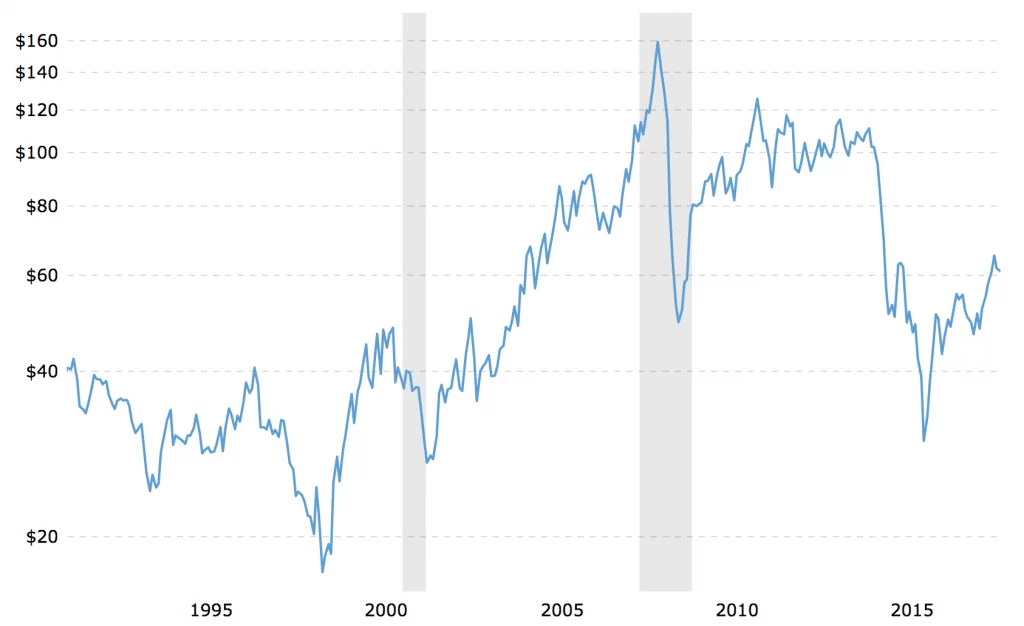If you’re hunting for gifted investors to draw inspiration from, you can’t find one much better than Seth Klarman.
Klarman’s investment prowess lead the Baupost Group, the investment partnership Klarman put together in 1982, to a 20% compound annual rate of return and a $1.5 billion US personal fortune (1).
What’s more impressive is that Klarman has been able to do this while sitting on a good chunk of cash, typically a drag on long term performance, and his fund’s enormous growth to $31 billion in assets as of 2016.
What’s important for our purposes, though, is not Seth Klarman’s net worth or the size of his fund, but how he’s been so tremendously successful all these years. Read on!

Table of Contents
Seth Klarman’s Early Life
It all started when Klarman was was just 4 years old (1). Already engrossed with business, he gave a presentation to his classmates at school about buying stocks. He wouldn’t actually place his first order, however, until he was 10. I guess you could say he was a late bloomer.
Seth Klarman’s reason for buying the stock, Johnson & Johnson, was endearingly innocent, citing his frequent use of their bandages during his younger more spill-prone years. Despite his youthful ignorance, the stock tripled in value (1).
By 12 Seth Klarman was placing regular calls to his broker to obtain price quotes, and started a number of businesses from paper routes (like Buffett), to snow cone stands, snow shovelling, and stamp & coin sales (1). This first hand business experience -- as small as it was -- likely had a big impact on him as an investor.
After majoring in economics at Cornell in Ithaca New York, Seth Klarman landed an internship at Mutual Shares Fund under the tutelage of famed value investors Max Heine and Michael Price (1). This was undoubtedly the biggest influence on Seth Klarman’s early development -- both were firmly in the Graham camp as investors.
“I learned an enormous amount there -- probably more than I learned in my subsequent two years of business school,” Klarman said in a Ivey Business School lecture (2).
After nearly 3 years at the firm, Seth Klarman enrolled at Harvard Business School, then founded Baupost Group upon graduation (1).
Seth Klarman: Benjamin Graham Resurrected?
There’s really no question that Klarman is deep down the deep value and special situation investing rabbit hole. His investing philosophy is a natural continuation of Graham’s own deep-digging, number crunching, approach in mid-career.
At the heart of Seth Klarman’s overall strategy are three pillars: focus on risk before return, absolute over relative performance, and invest bottom up rather than top down (2).
It’s incredibly important to avoid losses -- and losses are the essence of risk. Most of Wall Street takes the opposite view -- looking at how much can be made before thinking about the associated risks, if at all. Klarman flips this on its head, considering risk before possible upside. In his insanely expensive investment classic, Margin of Safety, Klarman wrote (3):
“I to believe that avoiding loss should be the primary goal of every investor. This does not mean that investors should never encourage loss at all. Rather “don’t lose money” means that over several years an investment portfolio should not be exposed to appreciable loss of principle.”
To Klarman, risk is the probability of losing and how much you can lose if you do lose (2). To avoid loss, Klarman argued that investors should take an absolute rather than relative performance approach and opt for risk free assets such as US treasuries, only venturing into more “risky” securities when the risk/reward ratio is clearly in the investor’s favour (3). This catered to, what Klarman thought was, the average investor’s risk averse nature. He explains (3):
"... greater risk does not guarantee greater return. To the contrary, risky erodes return by causing losses. It is only when investors shun high risk Investments, thereby depressing their prices, that an incremental return can be earned which more than fully compensates for the risk incurred. By itself risk does not create incremental return; only price can accomplish that."
By seeking out safer securities that offer an exceptional upside potential, leveraging even a smaller compound annual return can build a large eventual windfall. This is a fact that Graham knew well which is why both men considered safety of principal job one. It’s not hard to see why Klarman chose value investing (3):
“Value investing is the discipline of buying securities at a significant discount from their current underlying values and holding them until more of their value is realized………. The disciplined pursuit of bargains makes value investing very much a risk-averse approach."
But to take advantage of this approach, investors must have the patience to see prices correct. Seth Klarman is a big fan of long term investing, rather than aiming for above average short term performance. You need to have patience and a willingness to stick with your strategy year after year, through periods of disappointment, in order to reap the windfall afforded to value or special situation investors.
Similarly, managers also face career risk, which forces them into a relative performance derby. As Buffett is fond of saying, it’s better to fail conventionally than to succeed unconventionally. This causes managers to hug the index closely rather than seek out unconventionally earned large returns. This is fundamentally opposed to Seth Klarman's investment advice regarding index funds, which he considers dangerous. Seth Klarman focuses on absolute returns, more or less uninterested in how the market performs. Rather, he focuses on how his portfolio performs and not losing money.
Part of this approach, according to Klarman, is the need to hold cash when you can’t find bargains. It’s ultimately better to hold a risk free asset than it is to corrupt your investment standards by buying stocks that do not offer much more upside than the risk you incur holding them.
As tiny investors, people managing less than $10 million USD, there’s always something delicious to buy -- even in the heated market of the early 2020s. The bottom rungs of the market cap ladder are just that inefficient. Investors stuck buying medium or large cap stocks have to compete much harder for returns and frequently run out of good ideas.
Finally, while macro events have a big impact on investing, they’re very hard to forecast and capitalize on (2):
“Nobody’s really good at forecasting over time. There’s a lot of people that can call one recession or one bear market but inevitably they get hung up on overstaying their welcome or looking for the same thing to happen more than once and history doesn’t exactly repeat.”
Conversely, it’s comparatively easy to pick stocks that are great bargains and have strong event driven catalysts, so it just makes sense to focus on this. This is the same approach that Graham took when managing his own funds -- always the bottom up investor, Graham earned great returns for his clients.
Investing According to Seth Klarman
So what exactly is an investment according to Seth Klarman?
A lot of people assume that an investment is anything that you buy hoping that it will rise in value over time. But, both Seth Klarman and Warren Buffett define an investment as an asset that spits off cash. Klarman goes one step further, however, to include assets that will return cash to shareholders at some point in the future (3).
Sorry to say, the baseball cards you collected as a teenager don’t count. Neither does your house, if you’re not renting it out. Rather, assets such as bonds which pay dividends or will provide a repayment of capital & accrued interest at the end of their life totally fit the bill. A stock, interestingly, can be an investment only if the investor has reason to expect the company to reward investors at some point in the future or some other special situation exists that will lead to a payout. Without some sort of special corporate action, stocks with questionable business models and no equity would be pure speculations. While the practical application of Klarman’s definition of investing is open to interpretation, like many things in life, you tend to know it when you see it.
While Seth Klarman is firmly a Grahamite, Klarman’s definition of investing is very different from Graham’s, who characterized an investment as a situation which provided both safety of principle and a good chance of an adequate eventual return.
Seth Klarman on Avoiding Risk: Diversification
Investing rather than speculating is a key aspect of Seth Klarman’s risk avoidance strategy, but in his book he lays out three other key ways an investor can reduce risk (3):
“There are only a few things investors can do to counteract risk: diversify adequately, hedge when appropriate, and invest with a margin of safety.”
Most investors think of good diversification first when it comes to protecting against risk. By diversifying your holdings, you can reduce the impact that one bad stock pick has on your portfolio. Rather than causing significant permanent loss, your loss is mitigated to a much smaller percentage of your portfolio. According to Klarman, you don’t have to own many securities to diversify well (3):
“Even relatively safe investments entail some probability, however small, of downside risk. The deleterious effects of such improbable events can best be mitigated through prudent diversification. The number of securities that should be owned to reduce portfolio risk to an acceptable level is not great; as few as ten to fifteen different holdings usually suffice.”
So you don’t have to break your back selecting a hundred stocks for your portfolio like Walter Schloss did. Klarman favors a much more concentrated portfolio than that. This moderate level of diversification has another key advantage, too. Like Buffett, Seth Klarman also favors concentrating on your top picks.
"My view is that an investor is better off knowing a lot about a few investments than knowing only a little about each of a great many holdings. One's very best ideas are likely to generate higher returns for a given level of risk than one's hundredth or thousandth best idea." (3)
Instead, Klarman favors diversifying not only in terms of the number of stocks in your portfolio but also among the sort of risks you take on. He explains (3):
“Diversification is potentially a Trojan horse. Junk-bond-market experts have argued vociferously that a diversified portfolio of junk bonds carries little risk. Investors who believed them substituted diversity for analysis and, what's worse, for judgment. The fact is that a diverse portfolio of overpriced, subordinated securities, about each of which the investor knows relatively little, is highly risky. Diversification of junk-bond holdings among several industries did not protect investors from a broad economic downturn or credit contraction. Diversification, after all, is not how many different things you own, but how different the things you do own are in the risks they entail.”
Seth Klarman on Avoiding Risk: Hedging
While diversification likely won’t protect you in a major market downturn, hedging would. Hedging is a strategy by which an investor buys some asset and then sells another related asset short to protect against a downturn in price. For example, an investor who buys undervalued blue chip stocks could sell the S&P 500 short to protect himself against a broad market decline and lock in the gap between the market and the valuation of his stocks.
But, like Seth Klarman says, hedging is not always appropriate and can be tricky to maintain. So, before you start hedging your portfolio, you should really understand what you’re doing.
Seth Klarman on Avoiding Risk: Margin of Safety
By far the best way to protect your downside, according to Klarman, is to buy with a large margin of safety, and Klarman devotes an entire chapter to it in his book.
The need for a large margin of safety should be obvious to most value investors -- but the degree of importance Seth Klarman places on it helps place him firmly in the deep value camp. While Buffett looks at good companies at fair prices, Klarman demands a large margin of safety (3):
"Because investing is as much an art as a science, investors need a margin of safety. A margin of safety is achieved when securities are purchased at prices sufficiently below underlying value to allow for human error, bad luck, or extreme volatility in a complex, unpredictable, and rapidly changing world."
Part of the reason for Klarman’s insistence on a significant margin of safety is due to acknowledging his own fallibility. For one, Klarman is well aware that he can’t predict what will happen in the future, so aims to buy at a large discount (3):
"It is precisely because we do not and cannot know all the risks of an investment that we strive to invest at a discount. The bargain element helps to provide a cushion for when things go wrong."
Warren Buffett tries to protect his downside by buying companies with significant competitive advantages to help them keep growing in the future. But Klarman doesn’t think he possesses the same amount of skill, so opts for a deep discount to his assessment of fair value. From an interview with Charlie Rose (4):
“I think Buffett is a better investor than me because he has a better eye for what makes a great business. And, when I find a great business I'm happy to hold it ...most businesses don't look so great to me.”
A very humbling statement from one of the world’s best investors.
How Seth Klarman Values Stocks: Going Concern Value
According to Klarman, there are really only 3 ways to value a stock: going concern value, liquidation value, and stock market value.
Going concern value is best suited to stable cash generating businesses. The category breaks down further into discounted cash flow and private market value.
Discounted cash flow valuation is well known to value investors, and so are its pitfalls. Klarman, like other value investing gurus, is quite critical of the approach and cautious when using it (3).
"An unresolvable contradiction exists: to perform present value analysis, you must predict the future, yet the future is not readily predictable."
When he does find a solid stable company, he prefers to develop a range of scenarios that may unfold for the company and the resulting profitability implications. To use the valuation strategy effectively, you really have to understand which levers can be pulled to influence the company’s bottom line. It’s not a simple matter of plotting out earnings growth over time. Rather, you need to assess the company’s individual cash flow items, developing different scenarios for each, and assess how those tweaks will impact the firm’s profitability.
After deciding on a range of earnings for the company going forward, Seth Klarman is then very cautious about the discount rate he selects. As with everything he does, conservatism is the name of the game (3):
“It is essential that investors choose discount rates as conservatively as they forecast future cash flows. Depending on the timing and magnitude of the cash flows, even modest differences in the discount rate can have a considerable impact on the present-value calculation.”
What about private market value?
In Klarman’s eyes, it’s a very questionable valuation strategy. Private market value is related to Net Present Value and (3) "values businesses based on valuation multiples that sophisticated prudent business people have recently paid to purchase similar businesses." A few pitfalls of private market value exist, however. The strategy fails to make meaningful differences between companies within or between industries, multiples vary over time, and sophisticated buyers do not always pay intelligent prices.
But, the biggest problem with the strategy, according to Seth Klarman, is that sophisticated investors end up using discounted cash flow valuation themselves, so investors are relying on their questionable ability to predict the future.
How Seth Klarman Values Stocks: Liquidation Value
Valuation gets much easier as investors shift to liquidation analysis, as analysis can simply come down to crunching numbers. It’s also highly profitable due to its conservative nature. As Klarman writes (3):
"The liquidation value of a business is a conservative assessment of its worth in which only tangible assets are considered and intangibles, such as going concern value, or not. Accordingly, when a stock is selling at a discount to liquidation value per share, a near and near rock-bottom appraisal, it is frequently and attractive investment.”
Some of the best investment strategies in existence rely on liquidation value analysis, such as Graham's net nets. Since liquidation value is really a worst-case valuation analysis, most companies are worth much more than liquidation value (3):
“A liquidation analysis is a theoretical exercise in valuation but not usually an actual approach to value realization. The assets of a company are typically worth more as part of the going concern than in liquidation, so liquidation value is generally a worst-case assessment. Even when an ongoing business is dismantled, many of its component parts are not actually liquidated but instead or sold intact as operating entities.”
This provides deep value investors with a serious edge, and special situation investors should take note. Focusing on finding special situations in this area of the market can pay huge dividends.
There are a number of ways that investors can leverage liquidation value. Net current asset value, or net net value, is one. This strategy simply takes the firm’s current assets and subtracts total liabilities and any other claim prior to the common stock to arrive at a rock bottom liquidation value. Investors can get even more conservative by calculating what Klarman calls net net working capital, essentially the same formula but where investors discount the current asset accounts before subtracting all claims prior to the common. The performance is fantastic (3):
"Even when a company has little ongoing business value, investors who buy at a price below net net working capital are protected by the approximate liquidation value of current assets alone. As long as working capital is not overstated and operations are not rapidly consuming cash, a company could liquidate its assets, extinguish all its liabilities, and still distribute proceeds in excess of the market price to investors.”
While this is a great strategy to use, it’s not the only way to leverage liquidation value. Another is what Seth Klarman dubs breakup value (3):
“Breakup value is one form of liquidation analysis; this involves determining the highest value of each component of a business, either as an ongoing enterprise or liquidation. Most announced corporate liquidations are really breakups; ongoing business value is preserved whenever it exceeds liquidation value."
Ironically, while a liquidation signifies the failure of a business, it can be a boon for investors. When they do actually happen, liquidations are often a positive catalyst for value realization (3).
How Seth Klarman Values Stocks: Stock Market Value
As the name implies, stock market value is the value a stock would be if it traded at the same multiples as the overall stock market. Investors usually use this valuation strategy to value pieces of a business or stocks in a portfolio (3). But this valuation strategy has its own limitations. As Klarman describes (3):
“You would not use stock market value to appreciate each of the companies in an industry. It would be circular reasoning to observe that since newspaper companies tend to trade in the market at, say, 8x pre-tax cash flow, that is what they must be worth. Knowing the stock market's appraisal for the newspaper industry would be of some use, however, in establishing the near-term trading price of the newspaper subsidiary about to be spun off to the shareholders of a media conglomerate."
This criticism makes sense given Seth Klarman’s definition of investing. Ultimately, an asset is only worth the cash it can distribute to investors. Market value, whatever multiple an industry is trading at in the stock market, needs to be a reflection of this possible distribution as well and could very well be wrong.
On the other hand, securities of the same type tend to be priced relatively the same in the market. If you expect a corporate event to distribute an asset, or a company’s problem to resolve quickly, then assessing what similar companies are trading at in the market may be a good shorthand guide to the profit you could realize on the investment.
Which one of these valuation tactics should you use when assessing a stock? Klarman says that you should use almost all of them to see what value each arises at (2). If the valuation diverges sharply from one to another, it’s time for extra caution (3).
“I Found a Cheap One, Seth Klarman. Now What?”
According to Klarman, a business doesn’t just have to be cheap, it has to be cheap for a decent reason and should have some reason for its expected rapid recovery. This is the event or catalyst in the event driven investing strategy.
Once a bargain has been identified, it is important to learn why it is a bargain. It could just be mis-pricing or there could be something significant on the horizon that will destroy value, or put the company in jeopardy. But it’s important to approach this task with a bit of skepticism. In the February 15th, 1999 issue of Barron’s, he wrote:
“You never know for certain why sellers are getting out but you may be able to reasonably surmise a rationale.”
Investors should try their best to understand the situation because once the problem is identified the stock becomes a better investment since the future can be better predicted (3).
"Many attractive investment opportunities result from market inefficiencies, that is, areas of the security markets in which information is not fully disseminated or in which supply and demand are temporarily out of balance. Almost no one on Wall Street, for example, follows, let alone recommends, small companies whose shares are closely held and infrequently traded; there are at most a handful of market makers in such stocks.”
These are ideal situations because real bargains can be picked up for seriously cheap prices. But Klarman cautions investors to look out for businesses that seem cheap but actually reflect almost certain future business deterioration (3).
"Investors should pay attention not only to whether but also to why current holdings are undervalued. It is critical to know why you have made an investment and to sell when the reason for owning it no longer applies.”
Smart investors bought oil companies in the late 1990s when oil prices were less than $30 per barrel. Roughly a decade later oil stocks had surged along with the price of oil and looked cheap due to low PE ratios or prices relative to cash flow. But, those same smart investors knew that these firms were doomed to see their profit deteriorate as the cycle progressed.

An investor can increase his or her odds of success by not only buying cheaply but also demanding a catalyst for value realization. Spotting a catalyst while a security is undervalued enhances your margin of safety, and eliminates an investor's dependence on market forces bringing about a profit (3):
"[The] accumulation of stock leading to voting control, or simply management's fear that this might happen, could lead to steps being taken by a company that case its share price to more fully reflect underlying value."
But outside pressure is not the only catalyst that investors can look for. A range of possible events exist that can speed up price recovery, thereby reducing risk (3). Not all catalysts are created equally, though (3):
"The orderly sale or liquidation of a business leads to total value realization. Corporate spinoffs, share buybacks, recapitalizations, and major asset sales usually bring about only partial value realization."
In other words, certain catalysts can give the company's shares a boost (corporate events that spin off assets, when management buys back shares, when a company takes on debt to buy shares in a recap, or the sale of a major asset) but not usually full value realization (3).
Seth Klarman’s View on When to Dump Your Stocks
A stock is almost worthless to you if you never sell it. But, selling is one of the hardest parts of investing -- so how should you decide when to sell?
"Decisions to sell, like decisions to buy, must be based upon underlying business value." (3)
Like Graham during mid-career, Klarman used valuation and opportunity cost as the main yardsticks to determine when to sell a stock. Interestingly, Ben Graham shifted to a more mechanical investment approach late in life, favouring mechanical rules for buying and selling -- but Klarman remains firmly committed to the same approach Graham used in mid-career.
"Exactly when to sell -- or buy-- depends on the alternative opportunities that are available. Should you hold for a partial or complete value realization, for example? It would be foolish to hold out for an extra fraction of a point of gain in a stock selling just before underlying value when the market offers many bargains. By contrast, you would not want to sell a stock at a gain (and pay taxes on it) if it were still significantly undervalued and if there were no better bargains available." (3)
Luckily for the small investor, there’s almost always better bargains available after a stock advances. Being able to invest in the bottom rung of the market cap ladder is a critical advantage small investors should leverage.
Seth Klarman on How to Succeed: Work Harder
Some investors approach investing casually, as if it were an activity that you could dip in and out of as your interest wanes. Successful long term investors know, however, that success depends on an investors ability to stick to executing their strategy well over the long term.
Seth Klarman shares the same view, but goes one step further in highlighting the need to approach investing as a serious full time activity. Part time effort is not enough for success, in his eyes.
"Investing, it should be clear by now, is a full time job. Given the vast amount of information available for review and analysis and the complexity of the investment task, a part-time or sporadic effort by an individual investor has little chance of achieving long-term success.”
But does this mean that you should quit your job right now to focus full time on your portfolio? Klarman writes (3):
“It is not necessary, or even desirable, to be a professional investor, but a significant, ongoing commitment of time is a prerequisite. Individuals who cannot devote substantial time to their own investment activities have three alternatives: mutual funds, discretionary stockbrokers, or money managers."
A pretty damning warning to small investors. But looking at the incredibly poor track record of mutual funds and even advisory services can really deflate the hopes of most investors. Large professional managers have not been able to beat the market and even the best value gurus have turned up weak performance over the last 20 years. Indeed, Seth Klarman even thinks that index investing is a bad idea.
But all is not lost -- and this is why I specifically invest in small, niche, deep value strategies and make them available to individual investors. There are a handful of truly outstanding strategies out there that can really make your portfolio sing without having to commit the amount of time the Klarman devotes to his portfolio.
The key is understanding which investment strategies offer the best returns and looking for a way to leverage them even if you lack the time or the skill needed to do so. If you don't have a team, then we recommend entering your email address below to receive notifications about new special situation opportunities, because it will radically reduce the time and effort it takes you to source investment ideas.
2. Ivey School of Business Lecture
3. Margin of Safety by Seth Klarman
4. Interview with Charlie Rose
Read next: Bill Ruane Sequoia Fund Buffett’s Ultimate Referral









